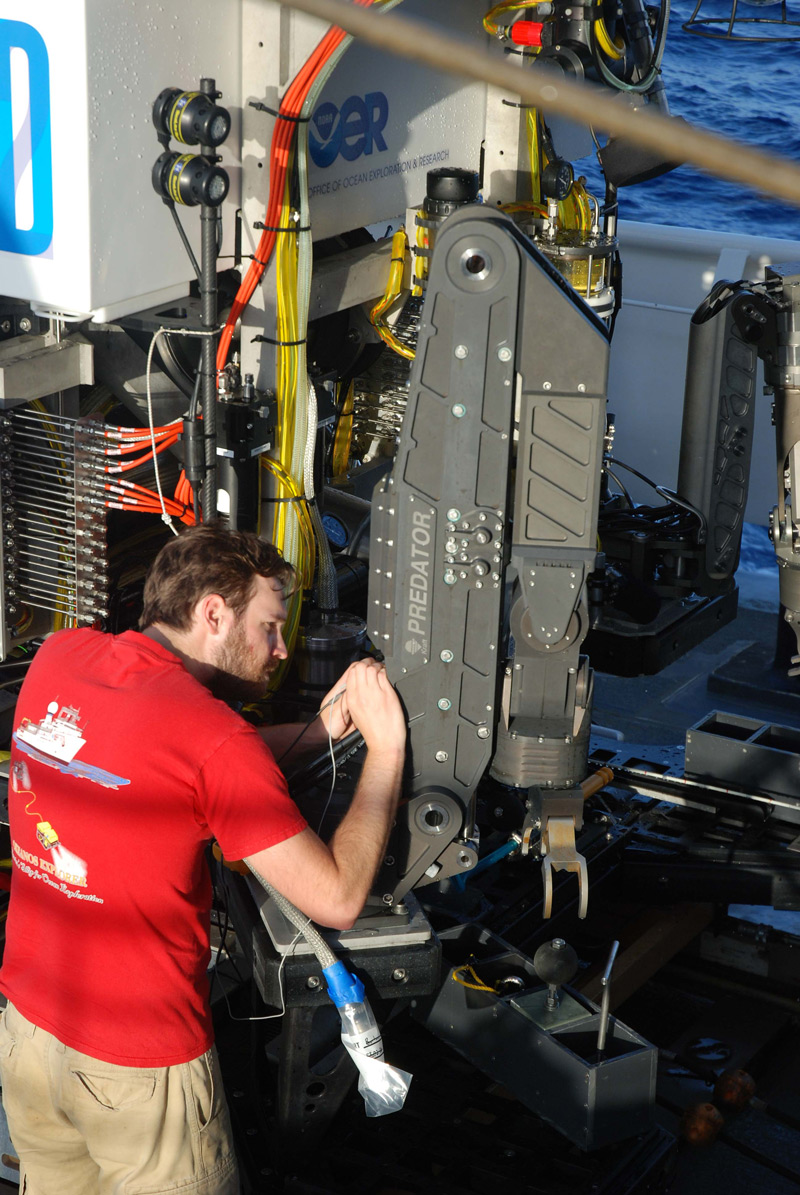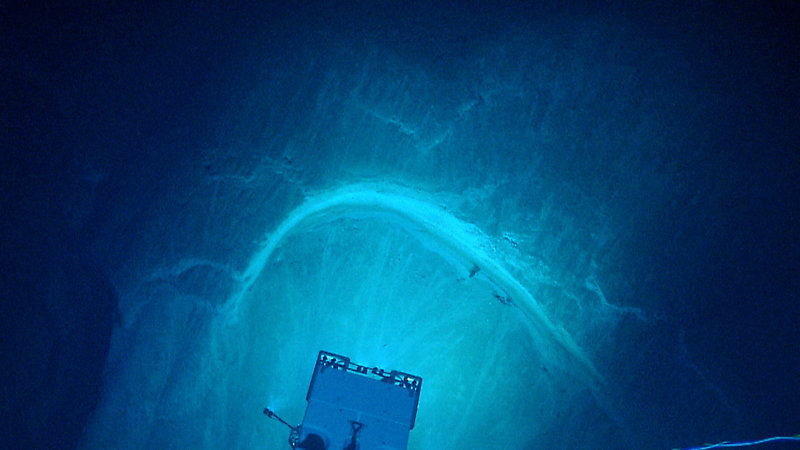
By Matt Dornback, Expedition Coordinator in Training, NOAA Ocean Exploration
June 13-27, NOAA Ocean Exploration will conduct a shakedown of its dual-body remotely operated vehicles (ROVs) Deep Discoverer and Seirios on NOAA Ship Okeanos Explorer in the Atlantic Ocean between Norfolk, Virginia, and Newport, Rhode Island. The expedition will include engineering test dives in water depths up to approximately 5,000 meters (3.1 miles). ROV dives will be conducted during the day with overnight mapping operations.

Remotely operated vehicles (ROVs) Deep Discoverer and Seirios are the stars of this expedition. Here, the ROV Team preps them for a dive during the Windows to the Deep 2018 expedition. Image courtesy of Art Howard, GFOE, Windows to the Deep 2018. Download image (jpg, 17.8 MB).
NOAA Ocean Exploration’s operations on Okeanos Explorer are back in full swing, and with this expedition we are continuing our contributions to the National Strategy for Exploring, Mapping, and Characterizing the United States Exclusive Economic Zone (PDF, 1.9 MB) and NOAA’s Atlantic Seafloor Partnership for Integrated Research and Exploration (ASPIRE) campaign. ASPIRE is a major multiyear, multinational collaborative ocean exploration field program focused on raising collective knowledge and understanding of the North Atlantic Ocean in support of the Galway Statement on Atlantic Ocean Cooperation, an initiative between the United States, Canada, and the European Union to advance knowledge of the Atlantic for improved ocean stewardship and understanding.
Prior to the 2021 field season, with the support of NOAA’s Office of Marine and Aviation Operations, Okeanos Explorer underwent an extensive dry-dock repair period to extend the operational lifespan of the ship and make system improvements. At the same time, the Global Foundation for Ocean Exploration performed extensive work on ROVs Deep Discoverer and Seirios, improving the ROV components and adding new scientific instruments. Finally, working with our partners at NOAA’s National Centers for Environmental Information, University of Rhode Island Inner Space Center (URI), and Ocean Networks Canada (ONC), we made improvements to our telepresence tools and procedures, enabling a better remote experience for explorers around the world.

During the expedition, our team of engineers will shake down systems and make repairs and adjustments that are needed to ensure everything is prepared for the rest of the field season. Image courtesy of NOAA Ocean Exploration, Océano Profundo 2015: Exploring Puerto Rico’s Seamounts, Trenches, and Troughs. Download image (jpg, 2.0 MB).
With all of these improvements, we need to have a shakedown! At the beginning of every field season, NOAA Ocean Exploration dedicates a series of days at sea to "shake down" and test the readiness of the ship's mission systems and the ROVs. During a shakedown, the systems undergo rigorous tests to ensure they are performing properly and are ready to be put to work. Given the complexity of the systems, we typically encounter glitches that need to be resolved. It takes engineers from multiple disciplines to get our operations in working order, so we will have mechanical, electrical, broadcast, network, telepresence, and software engineers aboard, along with a videographer and data managers, who will work together to make sure that everything is ready to go for the 2021 North Atlantic Stepping Stones: New England and Corner Rise Seamounts expedition.
During the expedition, we will conduct 24-hour-a-day ROV and mapping operations, with a focus on completing engineering priorities and testing new systems. Exact locations of ROV dives and mapping activities will be determined while at sea based on testing results and weather and operational constraints.

There’s no light in the deep sea, so we have to bring our own. New lighting on remotely operated vehicles Deep Discoverer and Seirios will enable better illumination of marine life and seafloor features. Here, the lights on Deep Discoverer shine on a spectacular bow-shaped, headwall scarp during Océano Profundo 2015: Exploring Puerto Rico’s Seamounts, Trenches, and Troughs expedition. Image courtesy of NOAA Ocean Exploration, Océano Profundo 2015: Exploring Puerto Rico’s Seamounts, Trenches, and Troughs. Download image (jpg, 1.1 MB).
During the day, we will take Deep Discoverer and Seirios on a series of progressively deeper dives on increasingly complex topography to test the brand new ROV control system, thruster motors, motor controllers, and hydraulic system on Deep Discoverer. We will also test new science and navigation instruments that were added to Deep Discoverer during the offseason, including an upgraded high-definition camera system, an extreme-low-light camera to take video in the dark, a dimmable LED lighting system, and a BlueView scanning sonar to detect objects beyond the reach of the ROV’s lights. The low-light camera will be tested and evaluated on Seirios before potentially testing it on Deep Discoverer.
At night, we will conduct mapping operations to close bathymetry gaps, collect new data where existing data is poor, and search for potential maritime heritage sites.

Mapping the ocean floor is the first step in exploring our ocean and is a key element of every NOAA Ocean Exploration expedition on NOAA Ship Okeanos Explorer. Here, a mapping watchstander in the ship’s control room edits multibeam data acquired during the 2017 Laulima O Ka Moana expedition. Image courtesy of NOAA Ocean Exploration, 2017 Laulima O Ka Moana. Download image (jpg, 91 kb).
As time allows, we will collect additional acoustic and dive data in support of ASPIRE to inform and support research planning and resource management in the region.
NOAA Ocean Exploration has always prioritized remote participation through telepresence on its expeditions aboard Okeanos Explorer. To improve the remote participation experience, we recently updated the graphical user interface on ONC’s SeaTube (the system we use for science annotations) and enhanced the webcasting tools, which are hosted by URI. In addition, we developed ways for scientists to provide live feedback on sample preservation and documentation from shore. Remote participation and connectivity is changing rapidly in many facets of our life, and we will continue to stay on top of the advancements in order to improve our collaboration tools and provide the best remote experience we can.

Ocean Networks Canada’s SeaTube is an important annotation tool for NOAA Ocean Exploration’s remotely operated vehicle (ROV) operations. This screenshot illustrates the annotation made by a shore-based scientist for a goniaster sea star observed during the 2019 Southeastern U.S. Deep-Sea Exploration expedition. Oceanographic sensor readings and the exact position of the ROV at the time of the observation are displayed below the video. Screenshot from SeaTube, Ocean Networks Canada. Download image (jpg, 359 kb).
A significant amount of the expedition will focus on training new members of our team on the existing systems and familiarizing everyone with the new systems. On this expedition, we have a new ROV pilot and expedition coordinator plus new crew members and sample data managers. The sample data managers will be testing a new approach to remote sample data management. New personnel will rotate through and shadow a number of different positions so they can learn as much as possible. As our operations often take the ship far offshore, it’s critical that personnel understand all aspects of operations so they are prepared to identify, troubleshoot, and solve any problem that may arise.

This map shows the general operating area and transects for NOAA Ocean Exploration’s 2021 ROV Shakedown expedition. Image courtesy of NOAA Ocean Exploration, 2021 ROV Shakedown. Download image (jpg, 720 kb).
Following departure from Norfolk, Virginia, we will conduct the initial engineering dives off the coast of North Carolina, moving progressively farther offshore and to deeper depths. We’ve identified some interesting sites for our tests and training, which is a nice bonus. Among them is Caryn Seamount. We plan to attempt the first dives ever on this seamount, which lies 440 miles off the coast of Virginia. Then, we will transit to the mid-Atlantic canyons to explore some unexplored canyons and a maritime heritage site proposed by the U.S. Navy. The expedition will end in the homeport of Okeanos Explorer, Newport, Rhode Island.

During this shakedown expedition, we will conduct test dives on the Currituck landslide, seen here with brisingid sea stars during the Windows to the Deep 2018 expedition. Image courtesy of NOAA Ocean Exploration, Windows to the Deep 2018. Download image (jpg, 770 kb).
Anyone with an internet connection can follow along with the expedition. NOAA Ocean Exploration will livestream video and data and share expedition news on this website and social media (Facebook , Twitter , and Instagram ).
All standard NOAA Ocean Exploration data collected on this expedition will be available in NOAA’s public data archives within 60-90 days of the conclusion of the expedition and accessible through NOAA Ocean Exploration’s Digital Atlas.